Table of Contents
INTRODUCTION
To say that Generative AI is revolutionising the workplace
is an understatement. In the last couple of years,
Generative AI or Gen AI has drastically changed how
organisations operate and make decisions. Its potential to
enhance efficiency and reshape roles is already creating
ripples across industries, with profound implications for
the workforce and the economy.
As the rate of AI adoption accelerates, it’s natural for
organisations and employees to feel apprehension and
anxiety about what this technology means for operations,
roles and job security.
While some fear AI might replace them, the truth is this:
AI won’t replace you—but someone who knows how to
work with AI will.
Empowering people with AI is not just about tools—it’s
about unlocking human potential. When employees
are equipped with the right knowledge and technology,
they don’t just work smarter—they innovate, lead and
transform the future.
In this e-book, we discuss how organisations can
integrate Gen AI into their workplace while addressing employee anxiety. We also consider aligning AI usage
with business needs and challenges while leveraging
AI tools to automate repetitive tasks. By doing so, you
can boost productivity, reclaim your time and focus on
strategic, creative and impactful work.
Let’s dive into how you can harness this transformative
tool to stay ahead in a fast-evolving world.
THE WORKFORCE OF TOMORROW: AI’S IMPACT
Generative AI is transforming workplaces and the economy, extending its impact beyond basic automation. It has the power to redefine traditional roles and generate entirely new job opportunities, driving productivity gains and revolutionising the way people work.
Job roles consist of a variety of tasks, with repetitive, routine ones being the most straightforward to automate. Generative AI doesn’t eliminate jobs but instead simplifies these mundane tasks, allowing employees to concentrate on higher-value responsibilities—a concept known as “job augmentation”.
By aligning business objectives with employee priorities, organisations can foster an environment where Gen AI not only enhances productivity but also empowers teams to focus on more meaningful and impactful work.

The National Bureau of Economic Research found that
a gen AI-based conversational assistant increased the
productivity of customer support agents by 14%, as
measured by the number of issues resolved per hour.


As AI continues to automate tasks, enhance roles and create new job opportunities, it is expected to drive economic growth by boosting productivity and fostering innovation, much like previous industrial revolutions. According to a Goldman Sachs report, Gen AI has the potential to increase global GDP by 7%—an extraordinary impact for a single technology.
Beyond Generative AI, a more advanced form of technology brings even greater innovation to organisations in the form of Agentic AI.
Agentic AI refers to smart systems that can independently observe, think and act in changing environments to achieve specific goals. Unlike Generative AI, which usually needs human guidance, Agentic AI can adapt, handle complex situations and perform tasks on its own.
These AI agents or tools can automate tasks usually requiring human effort by combining technologies like natural language processing, machine learning and robotics. They can understand their surroundings, make decisions and take actions to meet their objectives. Agentic AI has the power to transform industries by simplifying processes, improving decision-making and offering creative solutions to tough problems.
Deloitte predicts that in 2025, 25% of companies that use Gen AI will launch agentic AI pilots or proofs of concept, growing to 50% in 2027. Because the vision for agentic AI is compelling and the technology is evolving rapidly, companies should prepare themselves now, starting by embracing Generative AI.
GENERATIVE AI: YOUR PARTNER, NOT YOUR REPLACEMENT
Unlocking the full potential of generative AI starts with a mindset shift. Instead of viewing it as a threat, imagine it as your partner. Gen AI can be a powerful tool for enhancing capabilities across three key levels: individual, team and organisational.
Here’s how you can leverage AI agents at each level to create the greatest impact for your organisation:

Individual Level
Generative AI is a game-changer for getting results, especially when it comes to saving time and boosting efficiency. It takes routine tasks like drafting emails, analysing large datasets, managing schedules and even processing financial data off your plate, giving you the freedom to focus on what truly matters creativity, problem-solving and strategic thinking.
For instance, imagine you’re a data analyst using AI to generate an initial report. This saves you hours, allowing you to dive deeper into insights and craft strategies that drive real impact. In finance, an accountant or CFO could use AI to automate expense tracking, generate financial forecasts or identify anomalies in transactions, ensuring both accuracy and compliance while freeing up time for higher-value activities like budget planning or investment strategies.
Plus, AI agents act like proactive virtual assistants, flagging potential issues, suggesting optimisations or forecasting risks, whether it’s in your project timelines or financial workflows.
With AI handling repetitive tasks, you’re better equipped to innovate, tackle complex challenges and focus on professional development— boosting productivity, job satisfaction and even the bottom line. It’s about working smarter, not harder and achieving the results that truly matter.

Team Level
Teams are at the heart of success, and generative AI is here to supercharge their results. Clear communication, seamless collaboration and confident decision-making are the foundation of high-performing teams—areas where AI can make a real difference.
AI tools streamline workflows by prioritising tasks, generating meeting notes and summarising discussions, while features like real-time language translation enable effortless collaboration across geographies. Beyond that, AI agents actively support the team by identifying potential bottlenecks, suggesting process improvements and ensuring timely follow-ups on action items.
Use Case 1: Project Management and Task Alignment
A marketing team can use AI to automate task delegation and monitor project progress. By analysing deadlines and workload distribution, AI ensures no one is overwhelmed, flags risks like missed deadlines and provides a clear dashboard of actionable next steps. Team members stay aligned and focused on delivering campaigns without getting bogged down in administrative tasks.
Use Case 2: Cross-Functional Collaboration
A product development team working across multiple locations can leverage AI for real-time language translation during meetings, ensuring that language barriers don’t hinder collaboration. AI can also generate meeting minutes, highlight key decisions and summarise follow-up tasks, making it easy for all team members— regardless of role or location or even if they could not attend the meeting—to stay on the same page.
By reducing redundancies and delivering actionable insights, AI allows teams to focus on what truly matters: achieving their shared goals. With enhanced clarity and stronger cohesion, generative AI empowers teams to work at their best—unlocking productivity, driving results and aligning every effort with the organisation’s.

Organisational Level
Generative AI revolutionises organisational success by seamlessly integrating into key functions to optimise processes, enhance forecasting and foster strategic agility.
In sales, for instance, AI can analyse customer behaviour to deliver tailored recommendations, generate personalised outreach and predict purchasing trends. This empowers sales teams to focus on high-value leads while AI manages repetitive tasks, strengthening customer relationships and driving revenue growth.
Beyond sales, AI provides leaders with real-time insights into operational performance, identifies emerging market trends and suggests actionable strategies to stay ahead. In marketing, AI tools can dynamically adjust
campaigns based on consumer behaviour, ensuring more targeted and effective approaches.
By embedding AI across operations, organisations can drive innovation, respond to change with agility and maintain a competitive edge. Generative AI becomes a vital enabler of long-term success, powering growth and adaptability in an ever-evolving landscape.
INTEGRATING AI INTO YOUR ORGANISATION: A PRACTICAL GUIDE
Adopting AI is a journey requiring thoughtful planning and execution. Here’s how to ensure seamless integration and drive meaningful results.

Shift Mindsets
AI adoption starts with transforming perspectives. Employees may have mixed feelings, so it’s vital to show them how AI enhances their work. Cultivate a culture of curiosity and openness where employees are eager to learn and innovate with AI. Share success stories where AI has boosted productivity or job satisfaction and demystify fear and uncertainty to help to help them embrace change.

Identify Business Challenges
AI delivers value by addressing specific problems. Begin by identifying pain points and bottlenecks that hinder productivity, such as repetitive or errorprone tasks. Engage employees to pinpoint challenges and prioritise those where AI can deliver the most significant impact.
For example, a customer service team overwhelmed by repetitive queries can use AI-powered chatbots, freeing them to handle complex issues.

Educate Your Workforce
Equipping employees with the right skills is key to successful AI integration. Offer structured training programs, hands-on learning opportunities and ongoing education to build confidence and expertise.
- Structured Training Programs: Provide tailored training for all skill levels. Insentra’s Generative AI Sprint Series, for instance, offers practical sessions with tools like Microsoft Copilot and ChatGPT, accelerating results from experimentation to implementation
- Hands-on Learning: Enable employees to experiment with AI in real-world scenarios. Marketing teams could use AI for personalised campaigns, while sales teams might leverage analytics to prioritise leads
- Ongoing Education: Keep teams updated on AI advancements relevant to their roles, ensuring they stay ahead of the curve

Develop an Adoption Strategy
A clear adoption and change management plan ensures a smooth transition to AI.
- Set Clear Objectives: Define success, whether it’s efficiency, better customer experiences or innovation
- Stagger Implementation: Start with pilot projects in high-impact areas to refine processes before scaling
- Engage Employees: Involve employees early, gather input and address concerns to build trust
Insentra’s Adoption and Change Management services use proven methods like the ADKAR model to navigate technical and human challenges, ensuring AI adoption sticks and delivers maximum value.

Advance AI Responsibly
As AI becomes integral, ethical practices are essential.
- Establish Guidelines: Define acceptable AI use with a focus on transparency, fairness, and privacy
- Monitor Bias: Regularly review AI outputs for bias and alignment with organisational values
- Educate on Safe Use: Train employees on responsible AI use, addressing risks like misinformation and data privacy
- Create Accountability: Implement mechanisms for reporting misuse and ensuring ethical practices
By focusing on mindset, education, strategy and ethics, your organisation can harness AI’s full potential to innovate, adapt and thrive.
UPSKILLING FOR THE AI AGE
As AI continues to reshape industries, equipping employees with the right skills is essential to harness its full potential. Here are the key areas where professionals should focus their learning:
Fact-Checking AI Outputs
AI excels at generating content and insights, but it isn’t perfect. Employees must be equipped to critically evaluate AI outputs to ensure they’re accurate and reliable.

Spotting AI Hallucinations
AI systems, while powerful, sometimes produce “hallucinations”—false or misleading information presented as fact. Training employees to identify these inaccuracies is crucial.
To remain vigilant against AI hallucations, it’s important to not rely on a single model or tool. Employees can use one tool to generate content, and then another to review the prior’s output. For example, you can ask ChatGPT to review content produced by Copilot.
However, it’s important to remember that human intervention (human in the loop) is still key to accurate fact-checking. Employees should always check AI-generated data themselves using credible sources. It’s especially important to verify details in specialised domains where errors could have serious consequences, such as journalism.
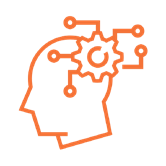
Critical Thinking in the Age of AI
AI doesn’t replace the need for human judgment. Encourage employees to question the outputs they receive, cross-reference information with trusted data and approach each result with a discerning eye. Providing employees with frameworks for critical thinking, like the CRAAP test (Currency, Relevance, Authority, Accuracy, Purpose), can help assess the reliability of information.
Practical Tip: Pair AI with tools like fact-checking websites or domainspecific resources to cross-verify content quickly and effectively.
Prompt Engineering
The quality of AI outputs depends heavily on how the AI is guided, which is where prompt engineering comes in. Teaching employees to master the art of prompt engineering can drastically improve outcomes.

Crafting Clear Prompts
An effective prompt is clear, contextually rich and directive. Employees should learn techniques like specifying tone, desired output format and context. Below is an example of a poor prompt and a good one.
- Poor prompt: What is AI?
- Good prompt: Explain AI in simple terms for a beginner audience. List its applications in healthcare in a table format, along with the sources.

Leveraging AI Personas
Introduce employees to the concept of assigning personas to AI for context to help tailor outputs to specific scenarios.
Here’s an example:
“Act as a copywriter for [company name]. Write a LinkedIn post promoting this new eBook entitled [title]”
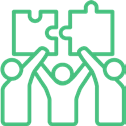
Cultivating a Culture of Prompt Sharing
Creating a culture of prompt sharing across teams is a great way to encourage continuous upskilling and development in prompt engineering. By encouraging teams to share tried-and-tested prompts, employees benefit from collective expertise by figuring out what makes an effective prompt.
Prompt templates save time, ensure consistency and streamline workflows, allowing teams to focus on higher-value tasks. This “write once, use many” approach reduces the need for trial and error, boosting productivity and fostering a shared commitment to innovation. Over time, this practice builds a dynamic repository of proven prompts, enabling the entire organisation to work smarter and achieve better outcomes.
We’ve listed a few prompts you can save for easy reuse in the latter part of the eBook so keep reading!
PRACTICAL PROMPT ENGINEERING TIPS

Be Specific and Clear: Provide detailed instructions to guide the AI. The more precise your prompt, the more accurate and relevant the output will be
Example: Instead of saying “Write about AI,” say “Write a 300-word article on how AI can improve team collaboration in remote work settings.”

Include Context: Add background information or context to help the AI understand your requirements. Specify the tone, audience and purpose of the output
Example: “Summarise this report for an executive audience, focusing on key metrics and actionable insights.”

Use Structured Guidelines: Break down your request into steps or a framework for complex tasks. This helps the AI process and organise the response effectively
Example: “Draft a marketing email with these sections: (1) Hook, (2) Product Benefits, (3) Call to Action and (4) Contact Information.”

Leverage Examples: Provide an example of the desired output to give the AI a model to emulate
Example: “Write a blog post introduction similar in tone to this example: ‘AI is reshaping the way we work. Here’s how your team can benefit.’ Include a hook that highlights benefits.”

Experiment with Iterations: If the initial output isn’t perfect, refine your prompt based on the response. Tweak instructions or add details for improvement
Example: After receiving a generic result, modify the prompt: “Make the tone more conversational and focus on how AI simplifies everyday tasks.”
EMPOWERING WORKFLOWS: AI TOOLS AND TEMPLATES
AI tools and templates are reshaping how professionals approach daily tasks by offering smarter, faster and more efficient ways to get things done. With accessible AI resources and practical examples, you can seamlessly integrate AI into your workflows, saving time and boosting productivity.
Accessible AI Tools
Gone are the days when leveraging AI required coding skills or expensive software. Today, numerous AI tools are available to simplify everyday tasks. Here are a few free or low-cost tools your teams can easily incorporate into their day-to-day work.

1. ChatGPT
ChatGPT is an advanced conversational AI tool designed to transform communication and enhance efficiency in organisations. With its ability to generate coherent, contextaware responses, ChatGPT supports tasks such as drafting emails, summarising documents, brainstorming ideas and providing instant customer service. Its adaptability and customisable tone make it an invaluable resource for streamlining workflows, improving collaboration, and boosting productivity.
OpenAI’s Models: GPT-4.0, GPT-4.0 Mini, and GPT-3.5 (O1)
OpenAI provides a suite of ChatGPT models tailored to meet diverse business needs. Here’s how the key models—GPT-4.0, GPT-4.0 Mini, and GPT-3.5 (O1)—can revolutionise your organisation:
GPT-4.0
- Capabilities: The flagship model, GPT-4.0, is designed for the most demanding tasks, delivering unparalleled accuracy, context-awareness and nuanced reasoning
- Use Cases: Ideal for crafting detailed reports, handling complex customer interactions, advanced problem-solving and strategic decision-making
- Benefits: Its deep understanding of context ensures high-quality outputs even for intricate queries, making it a go-to for mission-critical applications
GPT-4.0 Mini
- Capabilities: A lighter, more cost-efficient version of GPT-4.0, the Mini model balances high performance with reduced computational overhead
- Use Cases: Perfect for everyday tasks such as drafting communications, generating summaries and automating workflows where advanced depth isn’t required
- Benefits: Offers the sophistication of GPT-4.0 for routine tasks, optimising efficiency without overusing resources
GPT-3.5 (O1)
- Capabilities: A versatile, high-performing model that excels in conversational tasks, generating clear and concise outputs quickly
- Use Cases: Best suited for customer support, chatbots, quick content creation and simpler automations
- Benefits: Combines speed and cost-effectiveness, making it an excellent choice for organisations seeking scalable AI solutions

2. Copilot
Copilot integrates seamlessly with Microsoft 365, offering intelligent suggestions directly within apps like Word, Excel and Teams. It simplifies complex processes such as data analysis, content creation and project management by automating routine tasks and enhancing decision-making. With Copilot, you can foster collaboration and improve efficiency across teams.

3. HeyGen
HeyGen is a cutting-edge AI-powered video generation platform revolutionising how businesses and individuals create video content. By combining advanced artificial intelligence with intuitive tools, HeyGen enables users to produce high-quality, professional videos in minutes—no prior editing experience required.
Whether you’re crafting engaging marketing campaigns, personalised sales pitches or educational content, HeyGen simplifies the process while delivering visually compelling results. Its versatility, efficiency and creativity make it an essential tool for anyone looking to elevate their video production capabilities and captivate their audience.

4. VEED.io
VEED.io is a user-friendly video editing platform tailored for quick, professional content creation. It features automated tools like subtitles, background removal and templates, empowering organisations to produce engaging videos without extensive technical expertise. VEED.io helps businesses like yours save time while enhancing their digital presence and communication strategies.

5. Midjourney
Midjourney is an AI-powered image-generation tool that transforms text descriptions into stunning visuals. It enables organisations to create high-quality graphics, concept art and marketing materials effortlessly. By reducing reliance on traditional design processes, Midjourney accelerates creative workflows and supports innovation in branding and storytelling.
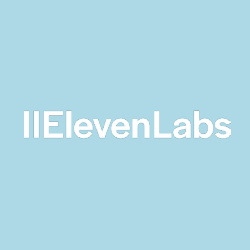
6. ElevenLabs
ElevenLabs revolutionises text-to-speech with natural, lifelike voice synthesis. Its multilingual capabilities and customisable voice profiles make it ideal for creating compelling audio content, from podcasts to training materials. By automating voice production, ElevenLabs helps you improve accessibility, audience engagement and content scalability.
Prompt Management Tools
Utilise advanced prompt management tools to create, organise and synchronise custom AI prompts across multiple devices. They also help you cultivate a culture of prompt sharing and standardisation throughout the organisation.
Below are a couple of tools you can try:
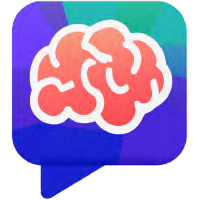
AI Prompt Genius
AI Prompt Genius is a Chrome extension allowing you to curate a custom library of AI prompts. This tool offers features such as customisable tags, folders and themes, making it easier to manage and access prompts efficiently. These features are particularly useful for those who frequently work with AI models, providing a streamlined and personalised experience.

Prompt Buddy
Prompt Buddy integrates seamlessly with Microsoft Teams, offering a shared space for teams to save and discover favourite AI prompts. Preloaded with categories like Microsoft Copilot, it also allows custom prompts for tailored AI tools. Users can “heart” impactful prompts, boosting them on the leaderboard for quick access. This easy-to-use Power App simplifies workflows and enhances team productivity.
Prompt Examples for Everyday Tasks
We’ve prepared a few prompts for everyday tasks that any professional can use. These are crafted to save time and improve efficiency, allowing you to focus on more strategic aspects of your work.
Whether you need to draft a quick email or transform a report into a visually appealing presentation, these ready-to-use prompts provide a solid starting point to enhance your productivity.
Data Analysis
Act as an expert data analyst specialising in extracing valuable insights from data. I will provide you with specific data analysis tasks, questions or datasets, and you will respond as an expert, offering analysis, recommendations or explanations as needed. Focus on data processing, statistical analysis, visualisation and interpretation of results. Do not provide unrelated details.
Summarise the findings, trends and highlights from this data set: [Input data here] Provide your analysis in a table format with the following columns: [Input relevant metrics here].
Employee Engagement
Your role is to function as an expert in employee engagement, and you are responsible for creating and implementing programs to improve employee satisfaction
and retention.
Your initial assignment is to develop a planto improve employee engagement and motivation for {{company name}} in the {{industry}} industry. Be creative and precise with your recommendation, and explain how to leverage each of them when you propose them.
Sales
Act as a sales expert who excels in prospecting, closing deals and sales strategies.
Give me 5 options for a value proposition for this product/service. [Describe the product/service here].
Write in a persuasive, engaging style, aiming to capture the audience’s attention and motivate them to take a specific action, such as purchasing a product or service. It should be creative, making use of slogans, catchy phrases and emotional appeals.
The tone should be [Describe the tone you want here] to match our brand’s personality
Email Marketing
Act as an email marketer who specialises in campaign planning, audience segmentation, content creation and performance analysis.
Suggest 10 email topics for a monthly newsletter about [Input niche or industry here]. Provide your suggestions in a table format with the following columns: Topic, brief description of the topic, sources, target audience.
Social Media Marketing
Act as a social media marketer who specialises in developing and executing social media strategies for brands.
Write a LinkedIn ad copy for this service: [Describe the service here].
Write in a persuasive writing style, aimed at convincing the readers to adopt a certain viewpoint or take a specific action. Combine logical arguments and emotional appeals to influence the reader to take action. Your writing tone should conversational but empathetic to appeal to the audience.
Website Copywriting
Act as a website content writer. Write an About Us page for this company [Input company website here]
Please write in [Input language here, e.g. Australian English]
Use clear, concise, user-friendly language. Your writing should be optimised for easy reading. Use attention-grabbing headlines, short paragraphs and bullet points. Incorporate SEO best practices to enhance visibility online. Follow the tone of the rest of the website to ensure cohesiveness.
STAY COMPETITIVE IN THE AGE OF AI
The future of work is here, and AI is leading the transformation. By embracing Generative AI, your organisation can empower teams, optimise operations, and unlock extraordinary potential. To fully harness AI’s power, upskilling is essential— and the Gen AI Sprint Series is your gateway to success.
Act now! Register today to gain both foundational and advanced Gen AI skills that drive real-world impact. Equip your team to thrive in an AI-driven world and stay ahead of the competition. Don’t wait—join the Gen AI Sprint Series and take the lead in shaping the future of work!
Reach out to us if you want to discuss your AI journey and how we can help to accelerate your plans.
ABOUT INSENTRA
WE DARE TO BE DIFFERENT

Insentra is a truly collaborative IT Services Partner delivering a range of specialised Advisory, Professional and Managed Services, transacting exclusively through the IT channel. Our partner-centric business model provides our Partners and their clients with access to technologies, industry expertise and accountable outcomes.
Our service offerings cover technologies by Microsoft, Citrix, Red Hat, AvePoint, IGEL, Rimo3, Nulia and many more across modern workplace, cloud, collaboration, security, support, migrations and more. We love what we do and are driven by a relentless determination to deliver exceptional service excellence. The combined individual skills, experiences and perspectives of our crew enable us to achieve powerful results for our Partners and their clients. For more information, visit www.insentragroup.com.
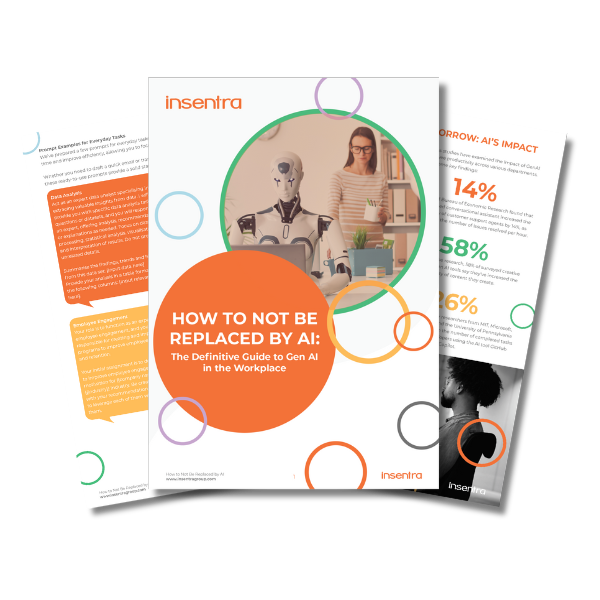
DOWNLOAD THE EBOOK
Thank you for downloading our eBook “How to Not Be Replaced by AI: The Definitive Guide to Gen AI in the Workplace.”
We’ve sent a copy to your inbox. Remember to mark hello@insentragroup.com as a “safe sender”, and to check any junk or spam folders so you receive your copy.

The Essential Guide to Sharepoint Premium
In 2024, content creation is at an all-time high, with a staggering two billion documents generated every day in Microsoft
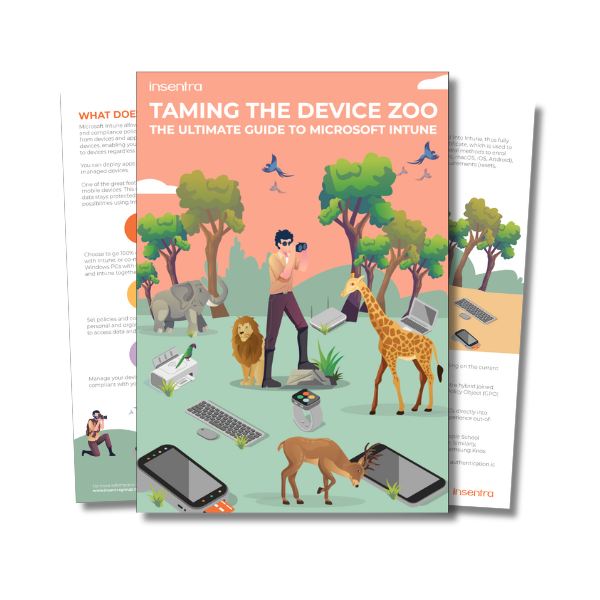
The Ultimate Guide to Microsoft Intune Whitepaper
Laptops, tablets, smartphones – it’s a jungle out there! Keeping them all secure, compliant and functioning smoothly can be a wild ride.
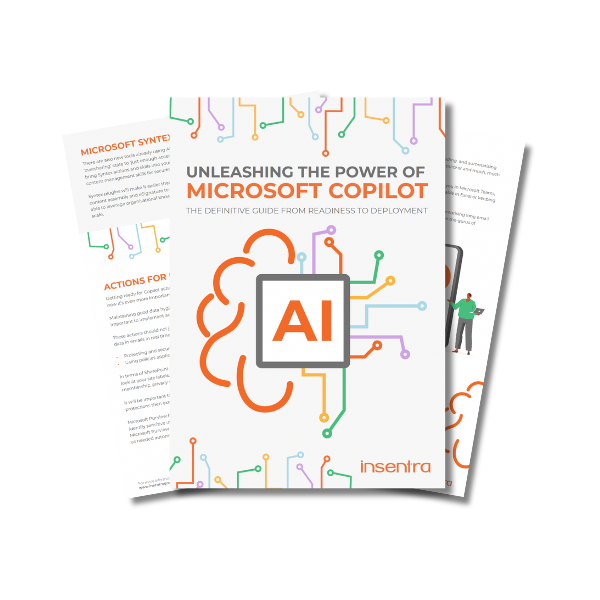
Unleashing the Power of Microsoft Copilot
THE DEFINITIVE GUIDE FROM READINESS TO DEPLOYMENT Are you ready to unlock the power of Microsoft’s revolutionary new AI assistant,











